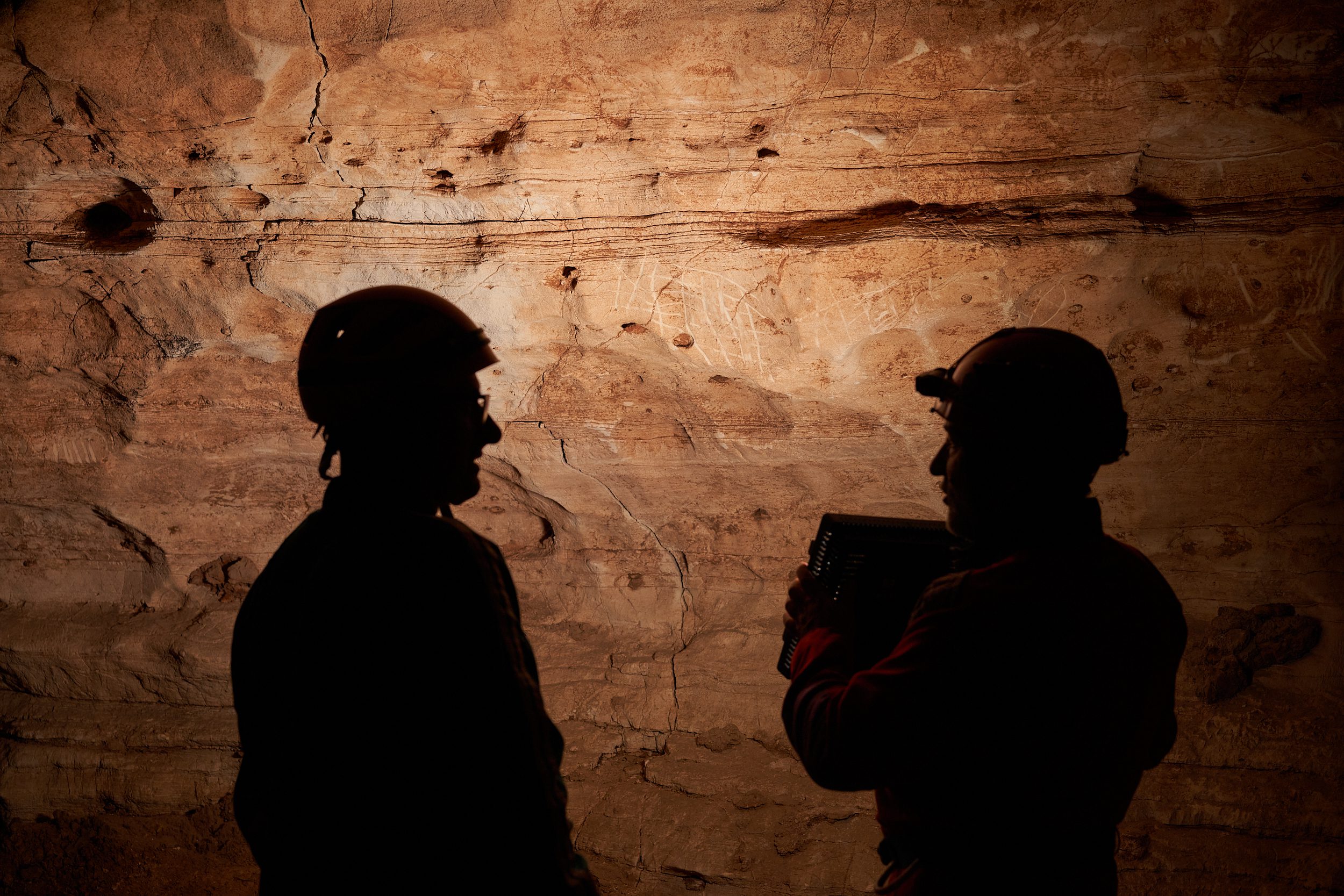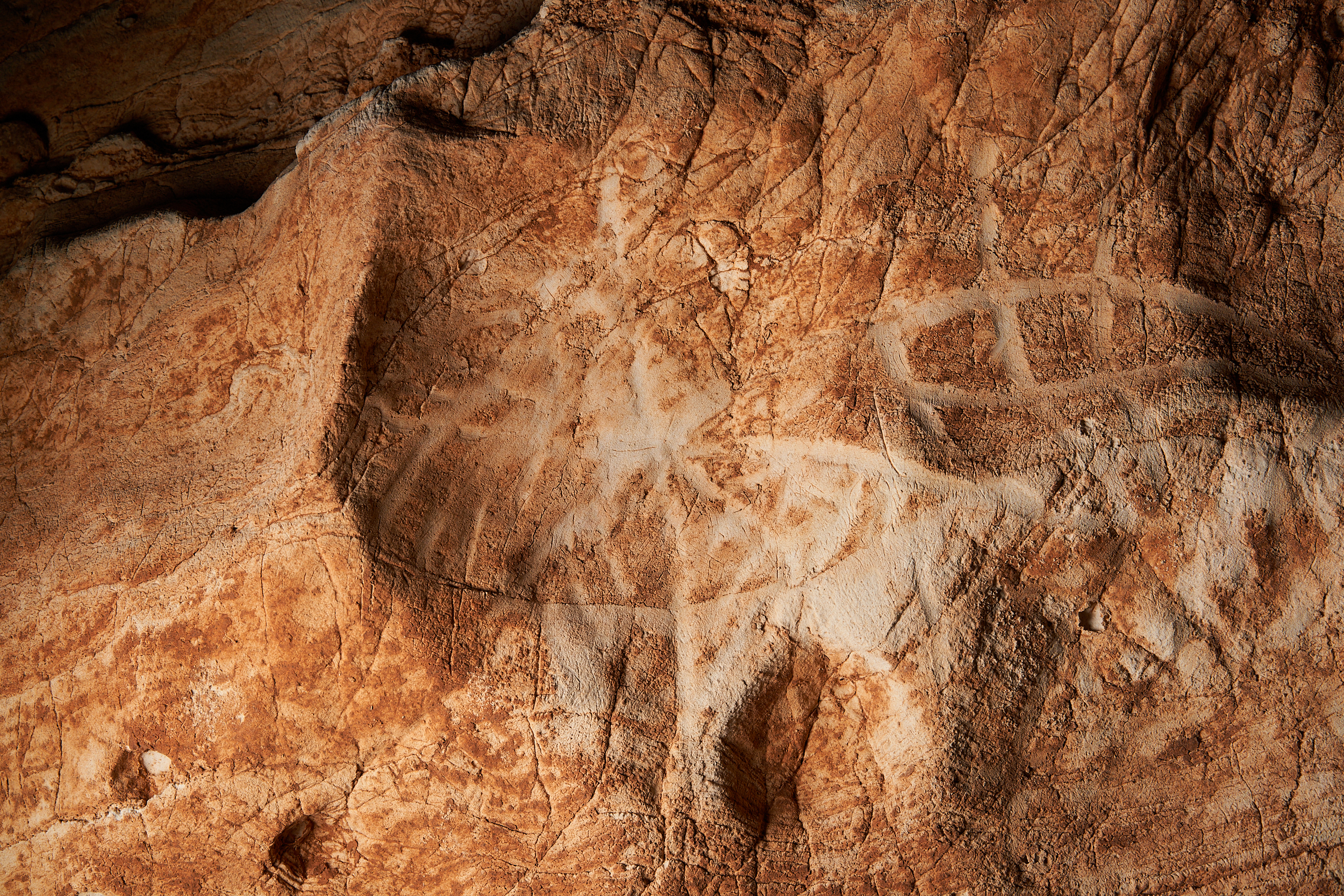Some time between 3,000 and 5,000 years ago, prehistoric shepherds in Catalonia covered the walls of a remote cave in doodles depicting their vision of the cosmos. Announcing the discovery of these ancient sketches, researchers say the artwork is unmatched by anything in the archaeological records and appears to be composed around some sort of deity with enormous eyes and a wide grin.
The find consists of more than 100 engravings spread over a section of wall measuring 8 meters (26.2 feet) in length. Located within a cave known locally as the Cova de la Vila, the artworks were located by researchers from the Catalan Institute of Human Paleoecology and Social Evolution (IPHES). In a statement, the institute describes the etchings as “exceptional as much for their uniqueness as for their excellent state of preservation.”
Among the IPHES team currently analyzing the discovery is Antonio Rodríguez-Hidalgo, who told IFLScience that “there are no paintings, only engravings.” While some of these etchings appear to have been made using sharpened stone flakes or bone points, others were embossed with nothing more than the artists’ fingertips.
“The first few millimeters of the surface of the rock is soft, and this allowed people to directly engrave these figures with their fingers,” said Rodríguez-Hidalgo. “In fact, this presents a problem when it comes to conservation, because even today if you were to put your hands on the wall, your fingerprints would remain on the surface.”

Members of the IPHES team inspect the engravings. Image credit: Arnau Pascual Monells / Departament de Cultura
The drawings themselves are split into three horizontal levels, the lowest of which is populated with basic zoomorphic shapes. “The figures seem to represent two different types of animals, possibly horses and bovines,” explained Rodríguez-Hidalgo. “However, they could really be anything because they are diagrammatic.”
The middle section, meanwhile, is plastered with “completely abstract drawings” which are extremely difficult to interpret but which might represent huts or other dwellings. Finally, the upper layer appears to represent the sky, and contains diagrammatic depictions of “stars or suns”.
The entire composition is dominated by what Rodríguez-Hidalgo described as “a central character that stands out because it is much larger than the other figures and is reminiscent of a symbol that is fairly common in late prehistory – in the Copper Age or early Bronze Age in the Iberian Peninsula – known as an idolo oculado [large-eyed idol].”
“[These figures] may represent a deity of some sort and are notable because they have large eyes.” In this case, the strange creature is depicted with “a large smile or beard and enormous eyes”.
While determining the exact age of these engravings is likely to prove difficult, Rodríguez-Hidalgo said that the presence of this central figure “places [the site] in a specific period of prehistory, between the end of the Neolithic and the start of the Bronze Age.” Within the context of the Iberian Peninsula, this equates to between three and five millennia ago.
At this stage, the meaning and function of these ancient carvings remain unknown, although numerous theories have been proposed. Though unproven, one such hypothesis states that the doodles represent a type of prehistoric graffiti, left by wandering shepherds who took refuge in the cave overnight or during storms.
Rodríguez-Hidalgo likened this to the modern tradition of writing one’s name or initials on monuments or subway carriages. “This is something very human, which we’ve probably been doing throughout our history,” he said.

The composition is split into three layers, with animals at the bottom and the heavens at the top. Image credit Arnau Pascual Monells / Departament de Cultura
However, noticing the stratified nature of the composition, the IPHES team are more inclined to believe that the illustrations represent the cosmology of these ancient pastoral societies. According to the group’s cave art expert Ramon Viñas, “the arrangement is far from random, and has a clear symbolic meaning.”
“The composition is absolutely unparalleled and speaks to us about the cosmovision of the local populations during the process of Neolithization.”
After conducting an initial search of the cavern, the team discovered a sea shell that may have been filled with animal fat and used as a torch by those who created the images. “In the next few months we will begin a small excavation to try and uncover more material culture from the time that the engravings were made,” said Rodríguez-Hidalgo.
“Hopefully that will give us a better idea of their age as well as their meaning.”
Source Link: Smiling Bug-Eyed God Seen In Unparalleled Prehistoric Cave Engravings